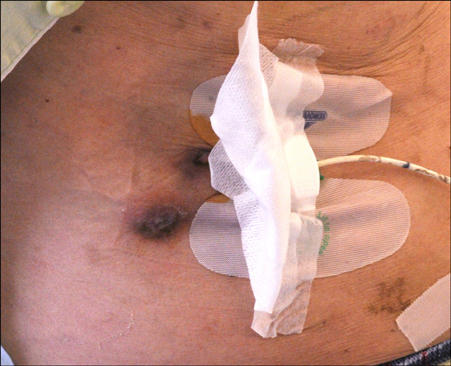Ann Dermatol.
2015 Apr;27(2):220-221. 10.5021/ad.2015.27.2.220.
A Case of Cutaneous Metastatic Cholangiocarcinoma on the Percutaneous Transhepatic Biliary Drainage Catheter Insertion Site
- Affiliations
-
- 1Department of Dermatology, Samsung Medical Center, Sungkyunkwan University School of Medicine, Seoul, Korea. dylee@skku.edu
- KMID: 2264819
- DOI: http://doi.org/10.5021/ad.2015.27.2.220
Abstract
- No abstract available.
MeSH Terms
Figure
Reference
-
1. Lee BK, Seo YH, Lee NH, Joo SY, Ko HM. Cholangiocarcinoma with distant cutaneous metastases. Korean J Gastroenterol. 2009; 54:342–345.
Article2. West KL, Selim MA, Puri PK. Cutaneous metastatic cholangiocarcinoma: a report of three cases and review of the literature. J Cutan Pathol. 2010; 37:1230–1236.
Article3. Chapman WC, Sharp KW, Weaver F, Sawyers JL. Tumor seeding from percutaneous biliary catheters. Ann Surg. 1989; 209:708–713. discussion 713-715.
Article4. Mizuno T, Ishizaki Y, Komuro Y, Yoshimoto J, Sugo H, Miwa K, et al. Surgical treatment of abdominal wall tumor seeding after percutaneous transhepatic biliary drainage. Am J Surg. 2007; 193:511–513.
Article5. Takahashi Y, Nagino M, Nishio H, Ebata T, Igami T, Nimura Y. Percutaneous transhepatic biliary drainage catheter tract recurrence in cholangiocarcinoma. Br J Surg. 2010; 97:1860–1866.
Article
- Full Text Links
- Actions
-
Cited
- CITED
-
- Close
- Share
- Similar articles
-
- Subcutaneous Implantation Metastasis of a Cholangiocarcinoma of the Bile Duct after Percutaneous Transhepatic Biliary Drainage (PTBD)
- Successful percutaneous management of bronchobiliary fistula after radiofrequency ablation of metastatic cholangiocarcinoma in a patient who has a postoperative stricture of hepaticojejunostomy site
- A Case of Implantation Metastasis of Gallbladder Cancer Following Percutaneous Transhepatic Biliary Drainage (PTBD)
- Percutaneous transhepatic biliary drainage
- Percutaneous transhepatic removal of common bile duct stone: a case report



